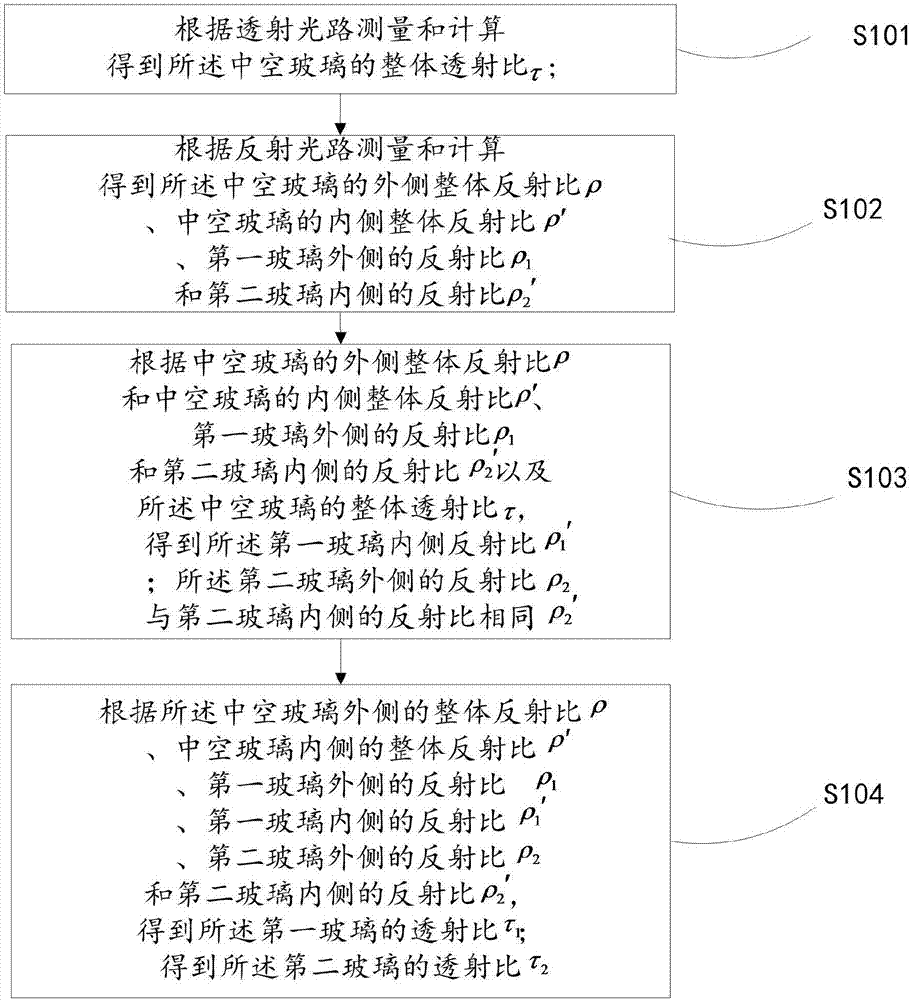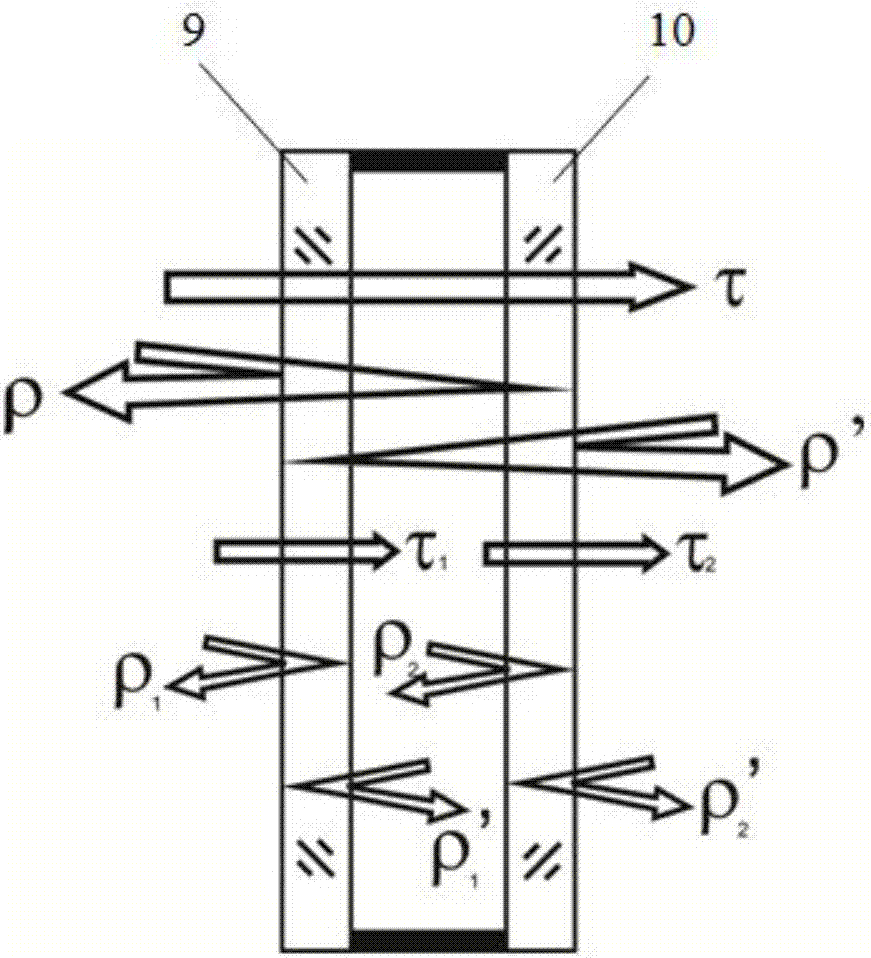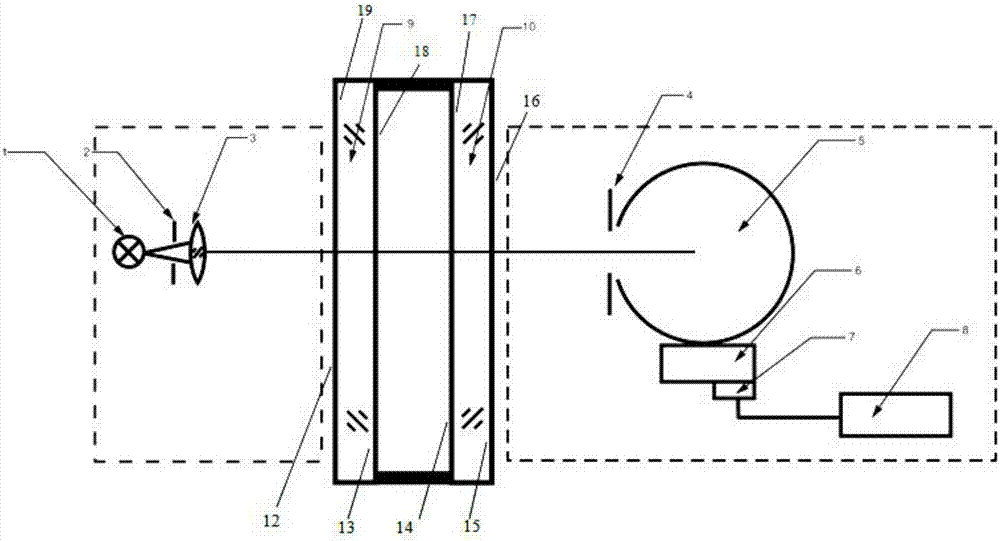Device and method for measuring transmission ratio and reflection ratio of hollow glass
A technology of reflectance and transmittance, applied in the field of optical detection of building energy-saving glass, can solve the problems of inability to detect the transmittance and reflectance of large pieces of tempered glass, inability to directly measure the reflectance of insulating glass, and inability to adapt to the detection of insulating glass. The effect of wasting material, improving applicability, and expanding detection range
- Summary
- Abstract
- Description
- Claims
- Application Information
AI Technical Summary
Problems solved by technology
Method used
Image
Examples
Embodiment 1
[0055] This embodiment provides a device for measuring the transmittance and reflectance of insulating glass, such as Figure 3-9 As shown, it includes: a transmitting device and a receiving device; the hollow glass includes a first glass 9, a hollow structure and a second glass 10;
[0056] The emission device includes a light source 1, a diaphragm 2 and a collimating lens 3 in turn; the light source 1 is used to provide light beams for the device, the diaphragm 2 is used to adjust the amount of incoming light of the light beams, and the collimation The lens 3 is used for collimating and focusing the adjusted beam;
[0057] The receiving device includes a slit adjusting device 4, an integrating sphere 5, a spectrum splitting device 6, a photodetector 7, and a signal acquisition and processing unit 8 in turn; the slit adjusting device 4 is used to adjust the progress of the integrating sphere 5. Amount of light; the integrating sphere 5 is a hollow complete spherical shell, t...
Embodiment 2
[0063] Such as figure 1 As shown, this embodiment provides a method for measuring the transmittance and reflectance of insulating glass using the device described in Embodiment 1, including:
[0064] S101. Measure and calculate the overall transmittance τ of the insulating glass;
[0065] Wherein, the transmitting device includes a light source 1, an aperture 2 and a collimating lens 3; the receiving device includes a slit adjusting device 4, an integrating sphere 5, a spectrum splitting device 6, a photodetector 7 and a signal acquisition and processing unit.
[0066] Specifically, such as image 3 as shown, image 3 The light path in is the transmission light path, the light beam of the transmission light path is emitted from the emitting device, and passes through the hollow glass to obtain transmitted light, and the transmitted light is received and processed by the receiving device to obtain the overall transmittance τ of the hollow glass; The insulating glass includes...
Embodiment 3
[0121] This embodiment provides another method for measuring the transmittance and reflectance of insulating glass using the device described in Embodiment 1. The difference between the method and the method provided in Embodiment 2 is that the outer reflection of the first glass The acquisition method of the inner reflectance ratio of the second glass is different from that of the second glass.
[0122] Specifically, such as Figure 8 Shown, the outside reflectance ρ of the first glass 1 The acquisition process is:
[0123] adjusting the amount of light entering the integrating sphere in the receiving device, and the emitting device shoots the light beam to the hollow glass from the outside of the first glass;
[0124] Corresponding reflections are all obtained after reflection from the first outer surface 12 of the first glass, the second outer surface 13 of the first glass, the second outer surface 14 of the second glass, and the first outer surface 15 of the second glass...
PUM
 Login to View More
Login to View More Abstract
Description
Claims
Application Information
 Login to View More
Login to View More - Generate Ideas
- Intellectual Property
- Life Sciences
- Materials
- Tech Scout
- Unparalleled Data Quality
- Higher Quality Content
- 60% Fewer Hallucinations
Browse by: Latest US Patents, China's latest patents, Technical Efficacy Thesaurus, Application Domain, Technology Topic, Popular Technical Reports.
© 2025 PatSnap. All rights reserved.Legal|Privacy policy|Modern Slavery Act Transparency Statement|Sitemap|About US| Contact US: help@patsnap.com



